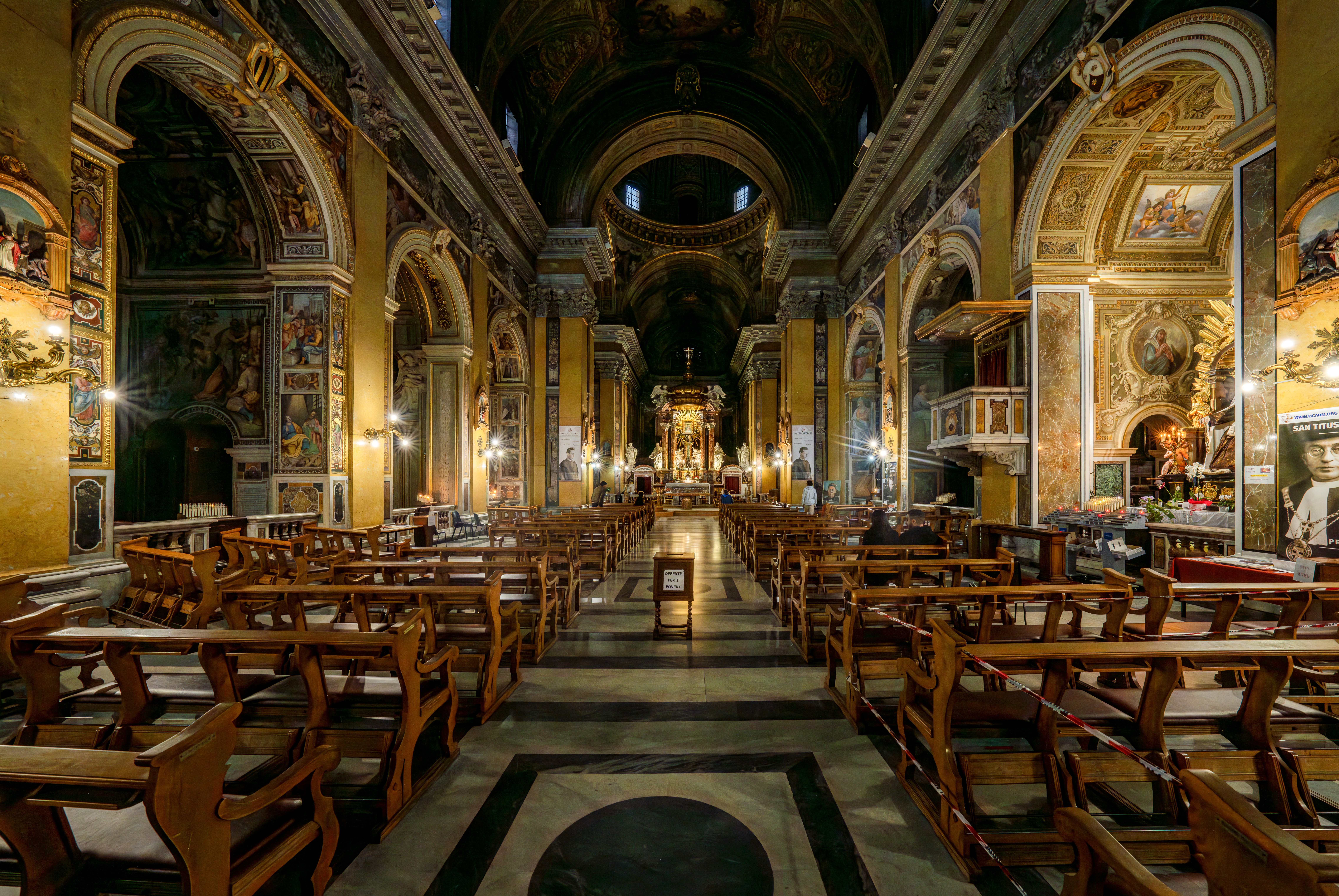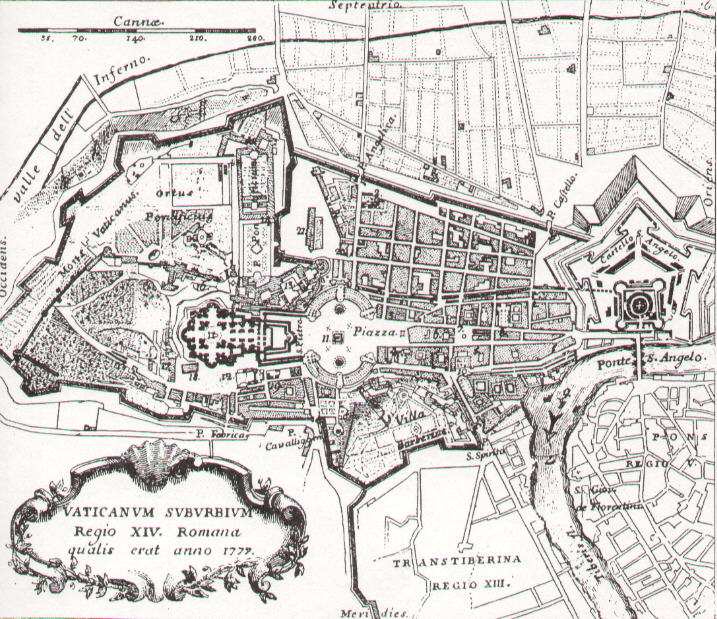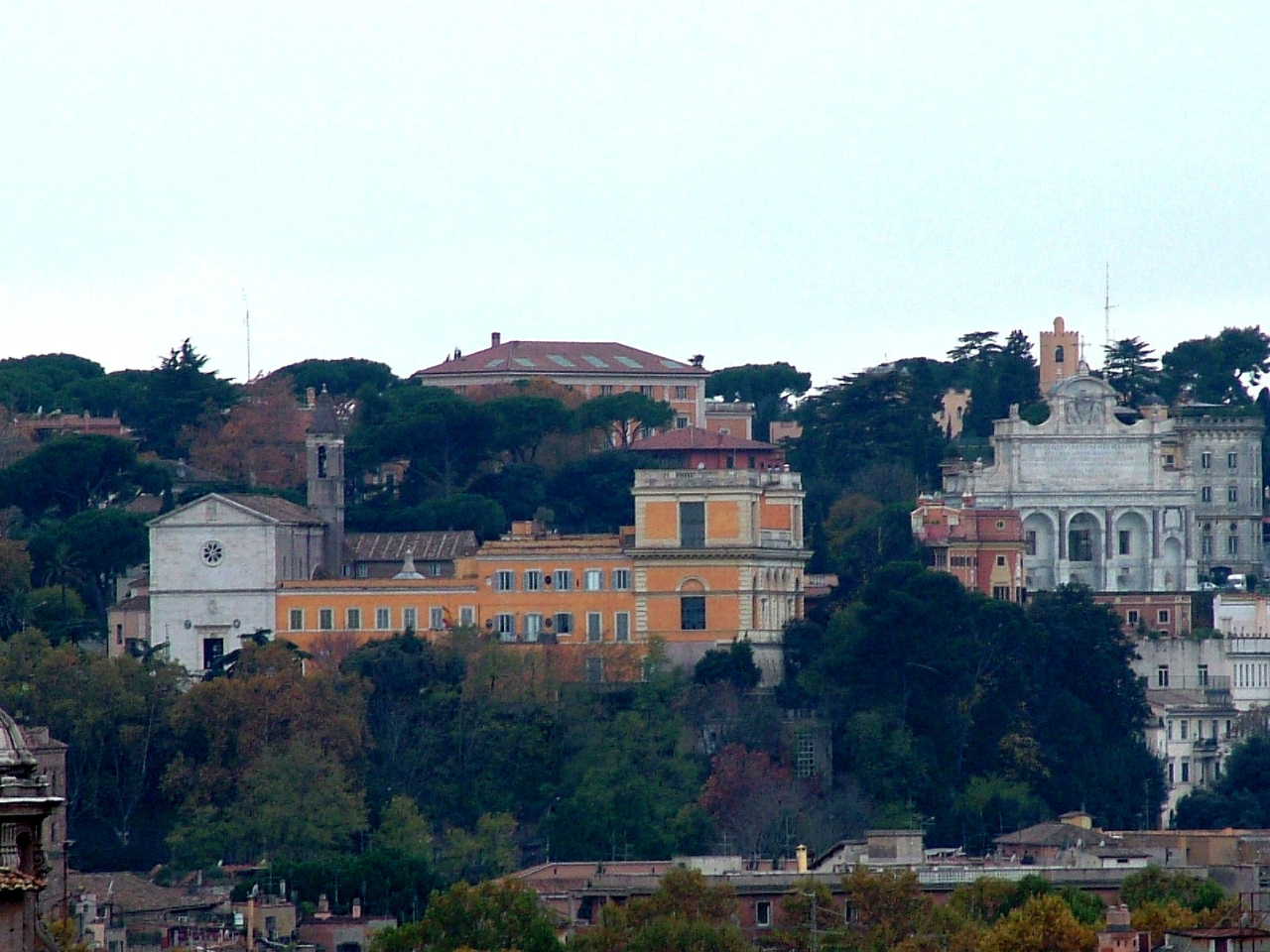|
Santa Maria In Traspontina
The Church of Santa Maria del Carmelo in Traspontina (Saint Mary of Carmel Across the Bridge) is a Roman Catholic titular church in Rome, run by the Carmelites. The bridge referred to is the Ponte Sant'Angelo. The church is on the Via della Conciliazione, the primary road of the Roman Rione of Borgo. Pope Sixtus V designated the church as a cardinalatial '' titulus'' on 13 April 1587. The current cardinal of Santa Maria in Traspontina is the former Archbishop of Quebec, Marc Ouellet, who is also the Prefect Emeritus of the Dicastery for Bishops of the Roman Curia. He was Cardinal Priest from 2003 to 2018, and continued there when co-opted to suburbicarian rank. It is the national church for Danish Catholics. History The first church named Santa Maria in Traspontina, which lay much nearer to the Tiber than today's church, was demolished during the pontificate of Pius IV (1559–1565) to clear the line of fire for the cannons of the Castel Sant' Angelo, who wished to ... [...More Info...] [...Related Items...] OR: [Wikipedia] [Google] [Baidu] |
Via Della Conciliazione
Via della Conciliazione ("Road of the Conciliation") is a street in the Rione of Borgo within Rome, Italy. Roughly in length, it connects Saint Peter's Square to the Castel Sant'Angelo on the western bank of the Tiber River. The road was constructed between 1936 and 1950, and it is the primary access route to the Square. In addition to shops, it is bordered by a number of historical and religious buildings – including the Palazzo Torlonia, the Palazzo dei Penitenzieri and the Palazzo dei Convertendi, and the churches of Santa Maria in Traspontina and Santo Spirito in Sassia. Despite being one of the few major thoroughfares in Rome able to cope with a high volume of traffic without congestion, it is the subject of much ire both within the Roman community and among historical scholars due to the circumstances under which it was constructed.Kirk, p. 1. The area around the church was rebuilt several times following the various Sacks of Rome, and again after having det ... [...More Info...] [...Related Items...] OR: [Wikipedia] [Google] [Baidu] |
Roman Catholic Archdiocese Of Quebec
The Archdiocese of Québec (; ) is a Latin Church ecclesiastical jurisdiction or archdiocese of the Catholic Church in Quebec, Canada. It is the oldest episcopal see in the New World north of Mexico and the Primate (bishop), primatial see of Canada. The Archdiocese of Quebec is also the Metropolis (religious jurisdiction), metropolitan see of an ecclesiastical province with the suffragan dioceses of Roman Catholic Diocese of Chicoutimi, Chicoutimi, Roman Catholic Diocese of Sainte-Anne-de-la-Pocatière, Sainte-Anne-de-la-Pocatière and Roman Catholic Diocese of Trois-Rivières, Trois-Rivières. The archdiocese's cathedral is Notre-Dame de Québec Cathedral, Notre-Dame de Québec in Quebec City. History New France From the beginning of colonisation of the New World, the Church influenced the politics and policies of New France. Even during the first voyages of Jacques Cartier in the 16th century, Priesthood (Catholic Church), missionary priests would accompany the Exploration, ... [...More Info...] [...Related Items...] OR: [Wikipedia] [Google] [Baidu] |
Borgo Nuovo (Rome)
Borgo Nuovo, originally known as via Alessandrina, also named via Recta or via Pontificum, was a road in the city of Rome, Italy, important for historical and architectural reasons. Built by Pope Alexander VI Borgia () for the holy year of 1500, the road became one of the main centers of the high Renaissance in Rome. Borgo Nuovo was demolished together with the surrounding quarter in 1936–37 due to the construction of Via della Conciliazione. Location Located in the Borgo ''rione'', the straight road stretched in E–W direction, between ''Piazza Pia'', which marks the entrance of the quarter near the right bank of the Tiber, and the north edge of ''Piazza Rusticucci'', which until its demolition was the vestibule of Saint Peter's Square. At about two thirds of its length, Borgo Nuovo crossed '' Piazza Scossacavalli'', the center of the Borgo. Together with the nearby road of Borgo Vecchio, of probable Roman origin, Borgo Nuovo delimited the so–called ''s ... [...More Info...] [...Related Items...] OR: [Wikipedia] [Google] [Baidu] |
Tholobate
A tholobate (), also called a drum or tambour, is the upright part of a building on which a dome is raised. It is generally in the shape of a cylinder or a polygonal prism. The name derives from the tholos, the Greek term for a round building with a roof and a circular wall. Another architectural meaning of ''drum'' is a circular section of a column shaft. Examples In the earlier Byzantine church architecture the dome rested directly on the pendentives and the windows were pierced in the dome itself; in later examples, between the pendentive and the dome an intervening circular wall was built in which the windows were pierced. This is the type which was universally employed by the architects of the Renaissance, of whose works the best-known example is St. Peter's Basilica at Rome. Other examples of churches of this type are St Paul's Cathedral in London and the churches of the Les Invalides, the Val-de-Grâce, and the Sorbonne in Paris. There are also secular buildings wit ... [...More Info...] [...Related Items...] OR: [Wikipedia] [Google] [Baidu] |
Francesco Peparelli
Francesco Peparelli (died 6 November 1641, Rome) was an Italian architect during the 17th century. According to a contemporary historian, Giovanni Baglione, between palaces, castles, churches and convents, Peparelli participated in about seventy construction projects but only about thirty can be attributed to him with certainty. Life In 1601 he was apprenticed to the architect Ottaviano Nonni and with him, contributed to the design of Santa Maria in Traspontina. He was skilled in engineering, cartography and hydraulics; and he was often commissioned with the construction of buildings designed by other architects. Peparelli often worked in various capacities with Girolamo Rainaldi, such as the Chiesa di S. Teresa in Caprarola. He also collaborated with Carlo Maderno in remodelling of existing structures, such as Santa Maria Maddalena. In 1620 he oversaw the renovation of the Palazzetto Mattei in the Villa Celimontana. Around 1630 Pope Urban VIII decided to rebuild the church of ... [...More Info...] [...Related Items...] OR: [Wikipedia] [Google] [Baidu] |
Ottaviano Nonni
Ottaviano Nonni (1536 – 6 August 1606), called Il Mascherino, was an Italian architect, sculptor, and painter born in Bologna. Apprentice of Giacomo Barozzi da Vignola, he was active in Emilia and in Rome, where he had been living in the rione of Borgo, in the road still bearing his name (''Via del Mascherino''). He was the architect of the Quirinal Palace under Pope Gregory XIII. His other works include the churches of San Salvatore in Lauro (1591), Santa Maria in Transpontina, the Bandini Chapel in San Silvestro al Quirinale, and the oval plan-design for the church of Santo Spirito in Sassia Church of the Holy Spirit in the Saxon District (Italian language, Italian: ''La chiesa di Santo Spirito in Sassia'') is a 12th-century Titular church, titular church in Rome, Italy. It is in ''Borgo Santo Spirito'', a street which got its name fr .... He died in Rome in 1606. References * * 1536 births 1606 deaths 16th-century Italian architects Architects from Bologna Ar ... [...More Info...] [...Related Items...] OR: [Wikipedia] [Google] [Baidu] |
Janiculum
The Janiculum (; ), occasionally known as the Janiculan Hill, is a hill in western Rome, Italy. Although it is the second-tallest hill (the tallest being Monte Mario) in the contemporary city of Rome, the Janiculum does not figure among the proverbial Seven Hills of Rome, being west of the Tiber and outside the boundaries of the ancient city. Sights The Janiculum is one of the best locations in Rome for a scenic view of central Rome with its domes and bell towers. Other sights on the Janiculum include the church of San Pietro in Montorio, on what was formerly thought to be the site of St Peter's crucifixion; a small shrine known as the Tempietto, designed by Donato Bramante, marks the supposed site of Peter's death. The Janiculum also houses a Baroque fountain built by Pope Paul V in the late 17th century, the Fontana dell'Acqua Paola, and several foreign research institutions, including the American and Spanish Academies in Rome. The Hill is also the location of The ... [...More Info...] [...Related Items...] OR: [Wikipedia] [Google] [Baidu] |
Castel Sant' Angelo
Castel Sant'Angelo ( ), also known as Mausoleum of Hadrian (), is a towering rotunda (cylindrical building) in Parco Adriano, Rome, Italy. It was initially commissioned by the Roman Emperor Hadrian as a mausoleum for himself and his family. The popes later used the building as a fortress and castle, and it is now a museum. The structure was once the tallest building in Rome. Hadrian's tomb The tomb of the Roman emperor Hadrian, also called Hadrian's mole, was erected on the right bank (or northern edge) of the Tiber, between 134 and 139 AD. Originally the mausoleum was a decorated cylinder, with a garden top and golden quadriga. Hadrian's ashes were placed here a year after his death in Baiae in 138, together with those of his wife Sabina, and his first adopted son, Lucius Aelius, who died in 138. Following this, the remains of succeeding emperors were also put here, the last recorded deposition being Caracalla in 217. The urns containing these ashes were probably placed i ... [...More Info...] [...Related Items...] OR: [Wikipedia] [Google] [Baidu] |
Cannon
A cannon is a large-caliber gun classified as a type of artillery, which usually launches a projectile using explosive chemical propellant. Gunpowder ("black powder") was the primary propellant before the invention of smokeless powder during the late 19th century. Cannons vary in gauge (firearms), gauge, effective range, mobility (military), mobility, rate of fire, elevation (ballistics), angle of fire and firepower; different forms of cannon combine and balance these attributes in varying degrees, depending on their intended use on the battlefield. A cannon is a type of heavy artillery weapon. The word ''cannon'' is derived from several languages, in which the original definition can usually be translated as ''tube'', ''cane'', or ''reed''. The earliest known depiction of cannons may have appeared in Science and technology of the Song dynasty#Gunpowder warfare, Song dynasty China as early as the 12th century; however, solid archaeological and documentary evidence of cannons do ... [...More Info...] [...Related Items...] OR: [Wikipedia] [Google] [Baidu] |
Field Of Fire (weaponry)
The field of fire or zone of fire (ZF) of a weapon, or group of weapons, is the area around it that can easily and effectively be reached by projectiles from a given position. Field of fire The term originally came from the ''field of fire'' in front of forts (and similar defensive positions), cleared so there was no shelter for an approaching enemy. Sector of fire A similar term sector of fire is used to describe the area into which each gunner or group are ''allowed'' to fire. The boundaries are assigned by the commanding officer and thus can be arbitrary, even three-dimensional (a rifleman attacking a building might be assigned a set of windows to target). Arc of fire The arc of fire of a mounted gun is a horizontal (" traverse") angle range within which the gun (or guns) can be fired. It can be limited by the construction of the gun mount or obstacles (for example, superstructure of a ship). If there are no restrictions, the term ''all-round arc of fire'' is sometimes used. ... [...More Info...] [...Related Items...] OR: [Wikipedia] [Google] [Baidu] |
Pius IV
Pope Pius IV (; 31 March 1499 – 9 December 1565), born Giovanni Angelo Medici, was head of the Catholic Church and ruler of the Papal States from 25 December 1559 to his death, in December 1565. Born in Milan, his family considered itself a branch of the House of Medici and used the same coat of arms. Although modern historians have found no proof of this connection, the Medici of Florence recognised the claims of the Medici of Milan in the early 16th century. Pope Paul III appointed Medici Archbishop of Ragusa, and sent him on diplomatic missions to the Holy Roman Empire and Hungary. He presided over the final session of the Council of Trent. His nephew, Cardinal Charles Borromeo, was a close adviser. As pope, Pius IV initiated a number of building projects in Rome, including one to improve the water supply. Life Early life Giovanni Angelo Medici was born in Milan on 31 March 1499 as the second of eleven children to Bernardino Medici and Clelia Serbelloni. Giovanni Medici ... [...More Info...] [...Related Items...] OR: [Wikipedia] [Google] [Baidu] |
Cardinal Priest
A cardinal is a senior member of the clergy of the Catholic Church. As titular members of the clergy of the Diocese of Rome, they serve as advisors to the pope, who is the bishop of Rome and the visible head of the worldwide Catholic Church. Cardinals are chosen and formally created by the pope, and typically hold the title for life. Collectively, they constitute the College of Cardinals. The most solemn responsibility of the cardinals is to elect a new pope in a conclave, almost always from among themselves, with a few historical exceptions, when the Holy See is vacant. During the period between a pope's death or resignation and the election of his successor, the day-to-day governance of the Holy See is in the hands of the College of Cardinals. The right to participate in a conclave is limited to cardinals who have not reached the age of 80 years by the day the vacancy occurs. With the pope, cardinals collectively participate in papal consistories, in which matters of importa ... [...More Info...] [...Related Items...] OR: [Wikipedia] [Google] [Baidu] |








